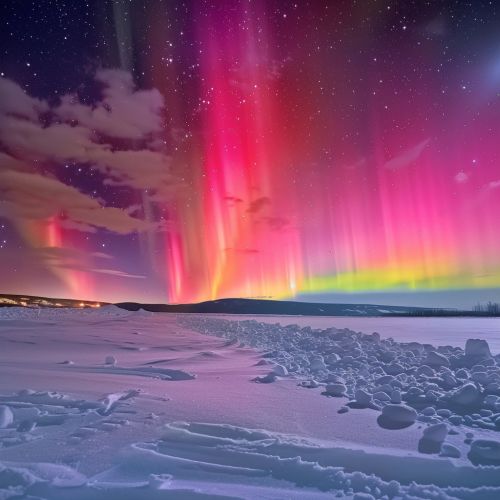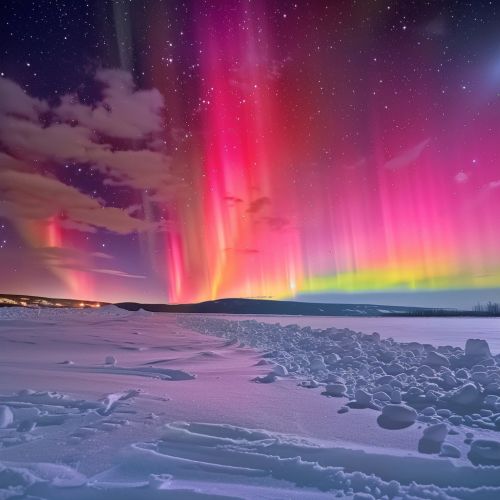Auroras
Introduction
Auroras, also known as polar lights, are natural light displays predominantly seen in high-latitude regions around the Arctic and Antarctic. These luminous phenomena are caused by the interaction between charged particles from the solar wind and the Earth's magnetosphere. The auroras are known as the aurora borealis in the northern hemisphere and aurora australis in the southern hemisphere.
Physical Mechanism
Auroras are the result of complex interactions between the solar wind, the Earth's magnetic field, and the atmosphere. The solar wind, a stream of charged particles emitted by the sun, carries with it a magnetic field. When these charged particles reach the Earth, they encounter the magnetosphere, which is the region around Earth dominated by its magnetic field.
Solar Wind and Magnetosphere Interaction
The solar wind compresses the Earth's magnetosphere on the day side and stretches it into a long tail on the night side. This interaction causes the acceleration of charged particles along the magnetic field lines toward the polar regions. When these particles collide with atoms and molecules in the Earth's atmosphere, they excite these atoms, causing them to emit light.
Particle Excitation and Emission
The primary atoms involved in auroral displays are oxygen and nitrogen. When high-energy electrons collide with these atoms, they excite them to higher energy states. As these atoms return to their ground state, they emit photons, producing the characteristic colors of the aurora. Oxygen emits green or red light, while nitrogen can emit blue or purple light.


Types of Auroras
Auroras can be classified based on their visual characteristics and the mechanisms that produce them. The two main types are diffuse auroras and discrete auroras.
Diffuse Auroras
Diffuse auroras are widespread, faint glows that cover large areas of the sky. They are produced by the scattering of electrons in the upper atmosphere and are typically less structured than discrete auroras.
Discrete Auroras
Discrete auroras are more structured and brighter than diffuse auroras. They appear as arcs, bands, or curtains of light and are caused by the direct precipitation of electrons into the atmosphere. These auroras are often seen as the classic aurora borealis or aurora australis.
Geographical Distribution
Auroras are most commonly observed in the auroral zones, which are regions around the magnetic poles. These zones are typically located between 60° and 75° latitude. The auroral oval, a ring-shaped region around each magnetic pole, is where auroras are most frequently observed.
Northern Hemisphere
In the northern hemisphere, the auroral oval is centered around the magnetic north pole. Countries such as Norway, Sweden, Finland, Canada, and Alaska in the United States are prime locations for observing the aurora borealis.
Southern Hemisphere
In the southern hemisphere, the auroral oval is centered around the magnetic south pole. The aurora australis is less frequently observed due to the limited landmass in the high southern latitudes, but it can be seen from Antarctica, southern New Zealand, and Tasmania.
Temporal Variations
Auroras exhibit temporal variations on multiple timescales, from minutes to years. These variations are influenced by solar activity, geomagnetic conditions, and the Earth's rotation.
Short-term Variations
Auroras can change rapidly, with structures appearing and disappearing within minutes. These short-term variations are driven by fluctuations in the solar wind and geomagnetic activity.
Long-term Variations
Auroral activity follows an 11-year solar cycle, with increased activity during periods of high solar activity, known as solar maximum. During solar minimum, auroral activity decreases.
Scientific Research
Auroras have been the subject of scientific research for centuries. Early observations were largely descriptive, but modern research employs sophisticated instruments and techniques to study the physical processes involved.
Ground-based Observations
Ground-based observatories equipped with all-sky cameras, spectrometers, and magnetometers are used to monitor auroral activity. These observations provide valuable data on the spatial and temporal characteristics of auroras.
Space-based Observations
Satellites equipped with particle detectors and imaging instruments provide a global perspective on auroral activity. Missions such as the NASA Polar satellite and the European Space Agency's Cluster mission have significantly advanced our understanding of auroral processes.
Cultural Significance
Auroras have been a source of wonder and inspiration for many cultures throughout history. They have been interpreted in various ways, from omens and portents to manifestations of divine beings.
Indigenous Beliefs
Many indigenous cultures in the Arctic regions have rich traditions and myths related to auroras. For example, the Inuit people of North America believe that auroras are the spirits of their ancestors playing in the sky.
Modern Interpretations
In contemporary culture, auroras are often seen as natural wonders and are popular subjects for photography and tourism. They continue to captivate people with their beauty and mystery.
See Also
References
- Akasofu, S.-I. (1981). "Aurora Borealis: The Amazing Northern Lights". Alaska Geographic Society.
- Eather, R. H. (1980). "Majestic Lights: The Aurora in Science, History, and the Arts". American Geophysical Union.
- Kivelson, M. G., & Russell, C. T. (1995). "Introduction to Space Physics". Cambridge University Press.
